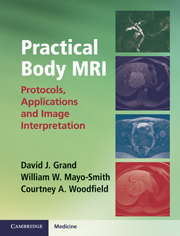Preface
Published online by Cambridge University Press: 05 November 2012
Summary
Preface
Body Imaging Divisions in the United States tend to be biased to either CT or MRI. This was the case at Brown/Rhode Island Hospital where CT dominated. Our Chairman, John Cronan, sought to remedy this imbalance by hiring recently trained experts in body and pelvic MRI, Drs. Grand and Woodfield.
My job as division director was to encourage the development of imaging algorithms and MRI protocols that optimized patient care. Like many academic institutions, we had had no hesitation about adding the latest sequence, but seldom took any away. Thus our protocols were lengthy and often it was not clear exactly what each sequence was used for. We needed to pare down extra sequences, minimizing imaging time without sacrificing quality or patient care. If we couldn't explain why we were running a sequence or if it was redundant, it was eliminated. This is a subjective matter and, like making sausages, not always a pretty scene.
What started as a handout for residents on their first tour of duty in body MRI became this book. It is not intended to be a reference and cover all aspects of every disease, but rather to quickly get a neophyte from “zero to fifty.” David and Courtney have done a great job of writing a short, practical book that teaches residents, fellows (and attendings) with minimal exposure to body MRI the most common MRI findings in the abdomen and pelvis.
- Type
- Chapter
- Information
- Practical Body MRIProtocols, Applications and Image Interpretation, pp. ixPublisher: Cambridge University PressPrint publication year: 2012



